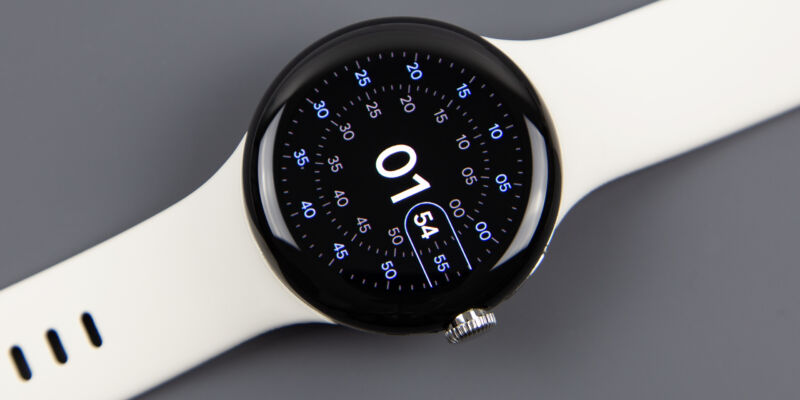
Enlarge / The Pixel Watch. It's a perfect, round little pebble. (credit: Ron Amadeo)
| SPECS AT A GLANCE: Pixel Watch | |
|---|---|
| SCREEN | 1.2-inch, 450×450 OLED (320 ppi) |
| OS | Wear OS 3.5 (Android 11) |
| CPU | Dual-core Samsung Exynos 9110 (10 nm)
Two 1.15 GHz Cortex A53 cores (plus a low-power Cortex M33 co-processor) |
| RAM | 2GB |
| GPU | Arm Mali T720 MP1 GPU |
| STORAGE | 32GB |
| NETWORKING | 802.11 b/g/n, Bluetooth 5.0, GPS, NFC, optional LTE |
| SIZE | 41×12.3 mm |
| WEIGHT | 36 g (without band) |
| BATTERY | 294 mAh |
| PRICE | $349 (Wi-Fi) $399 (LTE) |
| OTHER PERKS | 5 ATM water resistance, ECG sensor, SPO2 sensor |
It's hard to overstate how important the Apple Watch has become. It's the halo device for the entire Apple ecosystem, with something like a 30 percent attach rate on new US iPhone sales. There's nothing like the Apple Watch for Android phones, making it the reason to switch ecosystems from Android to iOS. If you're already on iOS, it's one of the primary reasons to stay. The Apple Watch is Apple's biggest lock-in weapon, and Google has spent the last few years doing absolutely nothing to fight it.
Google may have gotten to this market first with Android Wear in 2014, but its hardware progress came to a screeching halt in 2015 and hasn't moved much since. This was partly due to the company's reliance on Qualcomm SoCs, which have been released with the same basic chip design (under different model numbers) for six straight years. In addition, Wear OS hasn't had the greatest development effort, with major releases only occurring in 2014, 2017, and 2018. 2018 was also around the time that Google quietly quit Wear OS app development.
It's the usual situation: An Apple product has a focused, vertically integrated, laser-straight line of development, while the comparable Google product has to deal with a constantly shifting group of half-interested hardware partners, Google's internal attention deficit disorder, and at least one major rebrand. The Apple Watch ran away with the market while Google's efforts floundered, with the company capturing around 3 percent of the wearable market for several years.
Read 43 remaining paragraphs | Comments

Enlarge / The Pixel Watch. It's a perfect, round little pebble. (credit: Ron Amadeo)
| SPECS AT A GLANCE: Pixel Watch | |
|---|---|
| SCREEN | 1.2-inch, 450×450 OLED (320 ppi) |
| OS | Wear OS 3.5 (Android 11) |
| CPU | Dual-core Samsung Exynos 9110 (10 nm)
Two 1.15 GHz Cortex A53 cores (plus a low-power Cortex M33 co-processor) |
| RAM | 2GB |
| GPU | Arm Mali T720 MP1 GPU |
| STORAGE | 32GB |
| NETWORKING | 802.11 b/g/n, Bluetooth 5.0, GPS, NFC, optional LTE |
| SIZE | 41×12.3 mm |
| WEIGHT | 36 g (without band) |
| BATTERY | 294 mAh |
| PRICE | $349 (Wi-Fi) $399 (LTE) |
| OTHER PERKS | 5 ATM water resistance, ECG sensor, SPO2 sensor |
It's hard to overstate how important the Apple Watch has become. It's the halo device for the entire Apple ecosystem, with something like a 30 percent attach rate on new US iPhone sales. There's nothing like the Apple Watch for Android phones, making it the reason to switch ecosystems from Android to iOS. If you're already on iOS, it's one of the primary reasons to stay. The Apple Watch is Apple's biggest lock-in weapon, and Google has spent the last few years doing absolutely nothing to fight it.
Google may have gotten to this market first with Android Wear in 2014, but its hardware progress came to a screeching halt in 2015 and hasn't moved much since. This was partly due to the company's reliance on Qualcomm SoCs, which have been released with the same basic chip design (under different model numbers) for six straight years. In addition, Wear OS hasn't had the greatest development effort, with major releases only occurring in 2014, 2017, and 2018. 2018 was also around the time that Google quietly quit Wear OS app development.
It's the usual situation: An Apple product has a focused, vertically integrated, laser-straight line of development, while the comparable Google product has to deal with a constantly shifting group of half-interested hardware partners, Google's internal attention deficit disorder, and at least one major rebrand. The Apple Watch ran away with the market while Google's efforts floundered, with the company capturing around 3 percent of the wearable market for several years.
Read 43 remaining paragraphs | Comments
October 12, 2022 at 10:30PM

Post a Comment